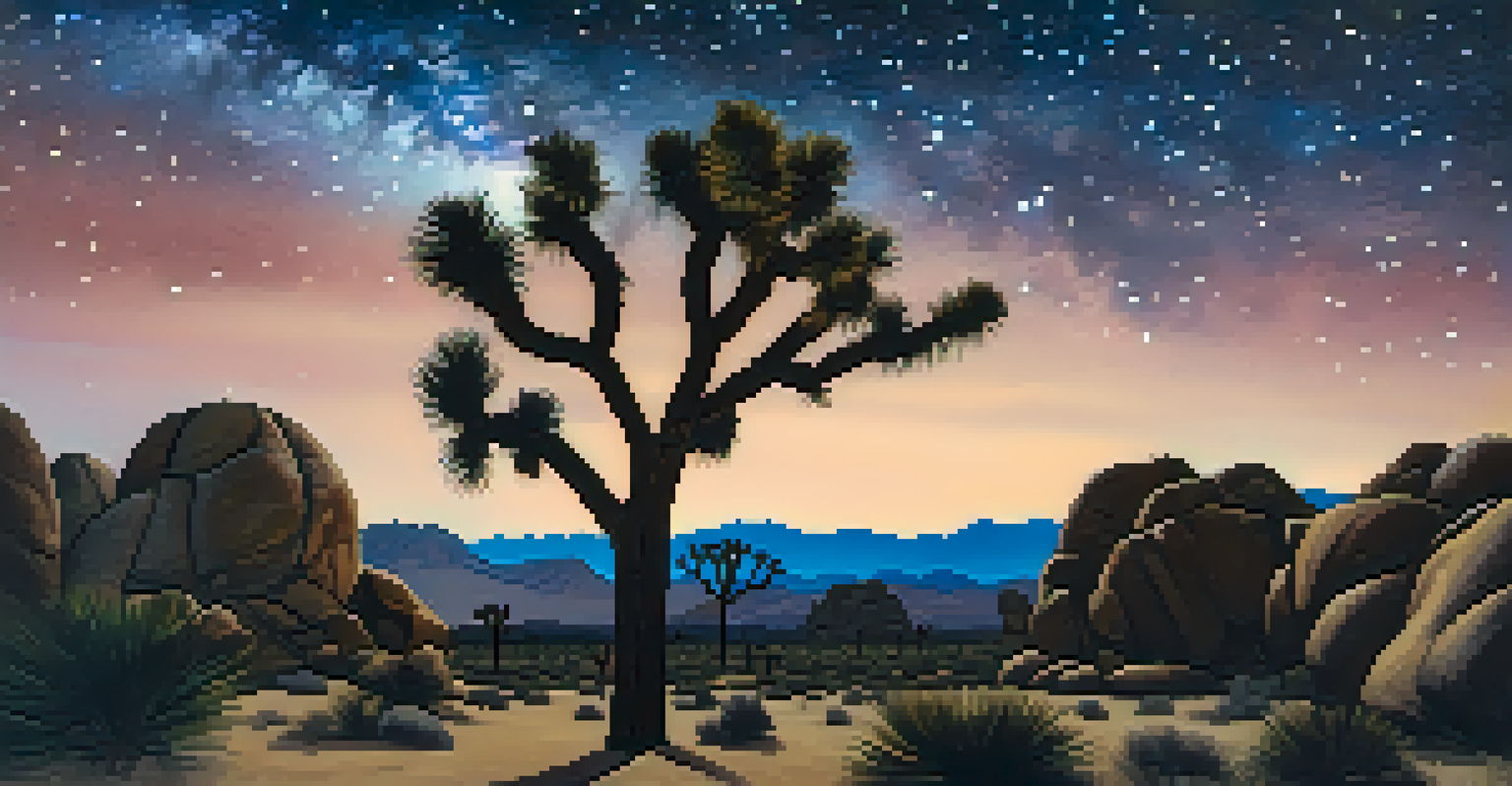California's National Parks: Guardians of Natural Heritage

Overview of California's National Parks and Their Importance
California is home to some of the most stunning national parks in the United States, each showcasing unique landscapes and ecosystems. These parks serve as vital sanctuaries for countless species, both flora and fauna, contributing to the state's rich biodiversity. From towering redwoods to majestic mountains, California's parks protect not only natural beauty but also cultural heritage.
In every walk with nature one receives far more than he seeks.
With over 9 million acres of preserved land, California's national parks play a crucial role in combating climate change. They act as carbon sinks, absorbing carbon dioxide from the atmosphere and helping to mitigate global warming. Furthermore, these parks provide opportunities for scientific research, allowing scientists to study ecosystems and climate effects in a natural setting.
Additionally, national parks are essential for recreation and mental well-being. They offer a space for hiking, camping, and connecting with nature, which can be incredibly therapeutic. As more people seek outdoor experiences, these parks become even more critical in fostering a sense of community and promoting environmental stewardship.
Yosemite National Park: A Jewel of Nature
Yosemite National Park, established in 1890, is renowned for its stunning granite cliffs, waterfalls, and diverse wildlife. Iconic features like El Capitan and Half Dome draw millions of visitors each year, making it a must-visit destination for nature lovers. The park's unique geology tells a story of ancient glacial activity, showcasing nature's incredible power.

In addition to its breathtaking scenery, Yosemite is a hotspot for biodiversity, hosting over 400 species of vertebrates. The park's varied habitats range from oak woodlands to alpine meadows, providing homes for animals like black bears and mule deer. It's vital to protect this habitat as climate change poses threats to these delicate ecosystems.
California's Parks and Biodiversity
California's national parks protect unique ecosystems and wildlife, contributing to the state's rich biodiversity.
Yosemite also emphasizes the importance of conservation and education. The park offers numerous programs that educate visitors about its natural and cultural history, inspiring them to become advocates for the environment. This blend of natural beauty and educational opportunity makes Yosemite a true treasure in California's national park system.
Sequoia and Kings Canyon: Giants of the Forest
Sequoia and Kings Canyon National Parks are famous for their towering sequoia trees, some of the oldest living organisms on Earth. These ancient trees can grow over 300 feet tall and have been around for thousands of years, showcasing the resilience of nature. Walking among these giants is a humbling experience that reminds us of our place in the world.
The clearest way into the Universe is through a forest wilderness.
The parks are also home to diverse landscapes, from rugged mountains to deep canyons, offering a variety of recreational activities. Visitors can hike, camp, and explore the vast wilderness while experiencing the beauty of the Sierra Nevada. This variety ensures that every visitor can find something that resonates with their love for nature.
Additionally, conservation efforts are paramount in these parks due to the threats posed by climate change and invasive species. Park rangers and volunteers work tirelessly to protect these ancient trees and their habitats. By visiting and supporting these parks, people can contribute to their preservation for future generations.
Joshua Tree National Park: A Desert Wonderland
Joshua Tree National Park, named after its unique Joshua trees, offers a stark contrast to California's other national parks. The park's surreal landscapes, with its rock formations and desert flora, create a captivating environment that draws artists and adventurers alike. This distinctive ecosystem is a testament to nature's diversity and adaptability.
The park is not only visually stunning but also rich in biodiversity, home to various plant and animal species that thrive in arid conditions. From the iconic yucca plants to the elusive desert tortoise, Joshua Tree showcases the importance of desert ecosystems. Understanding these ecosystems can help us appreciate the fragile balance of life in such harsh environments.
Recreation and Mental Well-Being
These parks offer vital recreational spaces that promote mental health and foster community connections.
Moreover, Joshua Tree is a perfect spot for stargazing, as it was designated a Dark Sky Park. The clear desert skies allow visitors to see stars and celestial phenomena that are often obscured in urban areas. This connection to the universe provides a unique experience and reinforces the idea of preserving natural spaces for future generations.
Channel Islands: A Remote Paradise
The Channel Islands National Park, consisting of five islands off the Southern California coast, is often referred to as America's Galapagos. This remote park is home to unique species found nowhere else on Earth, making it a critical area for conservation. The isolation of the islands has allowed these species to evolve independently, showcasing nature's creativity.
Exploring the Channel Islands reveals a wealth of biodiversity, from sea lions to endemic plants. The ocean surrounding the islands is equally rich, with vibrant marine life that attracts snorkelers and divers. The park's diverse ecosystems provide an opportunity to study how life adapts to different environments, highlighting the importance of protecting these natural habitats.
Visitors to the Channel Islands can enjoy activities like kayaking, hiking, and wildlife watching, offering a chance to connect with nature in a pristine setting. The park's remoteness enhances the experience, allowing visitors to escape the hustle and bustle of everyday life. By appreciating and supporting this unique environment, we contribute to the preservation of its natural heritage.
Lassen Volcanic National Park: A Geothermal Wonder
Lassen Volcanic National Park is a hidden gem in California, showcasing a fascinating landscape shaped by volcanic activity. From bubbling mud pots to steaming fumaroles, the park offers a glimpse into the Earth's geothermal processes. This dynamic environment not only captivates visitors but also serves as a living laboratory for geological studies.
The park is home to a variety of ecosystems, including alpine, forest, and volcanic landscapes. Each habitat supports a diverse range of wildlife, from black bears to rare plant species. This biodiversity is vital for maintaining ecological balance and provides opportunities for visitors to learn about the interconnectedness of life.
Conservation Education Efforts
Education and conservation initiatives in the parks aim to raise awareness and ensure the preservation of natural resources.
Lassen Volcanic is also a place for recreation, with numerous trails for hiking and opportunities for camping. The park's unique features make it an educational destination for families and nature enthusiasts alike. By fostering appreciation for geothermal wonders, we encourage a deeper understanding of our planet's natural processes.
Point Reyes National Seashore: A Coastal Sanctuary
Point Reyes National Seashore is a breathtaking coastal park that showcases California's rugged coastline and diverse ecosystems. With its dramatic cliffs, sandy beaches, and lush forests, it offers a perfect escape for nature lovers. This park is a sanctuary for marine wildlife, including elephant seals and migrating whales, making it a hotspot for wildlife enthusiasts.
The park's unique location along the Pacific Flyway also attracts numerous bird species, providing excellent opportunities for birdwatching. Visitors can explore various trails that wind through different habitats, each offering a unique perspective on the coastal environment. This diversity enhances the overall experience, making every visit feel like a new adventure.

Additionally, Point Reyes emphasizes the importance of conservation and sustainable practices. The park collaborates with local communities to protect its natural resources and promote environmental stewardship. By visiting Point Reyes, we not only enjoy its beauty but also support efforts to preserve this coastal sanctuary for generations to come.
The Role of Education and Conservation in National Parks
Education and conservation are at the heart of California's national parks. Each park offers programs and educational resources that help visitors understand the importance of preserving these natural spaces. By engaging with park rangers and participating in workshops, visitors can learn about the ecological and cultural significance of the parks.
Conservation efforts are vital to maintaining the health of these ecosystems. National parks often face challenges such as climate change, invasive species, and habitat loss. By raising awareness and encouraging responsible visitation, parks aim to protect their unique environments and the species that inhabit them.
Moreover, the role of partnerships with local communities and organizations is crucial. Collaborations enhance conservation efforts and promote sustainable practices, ensuring that California's national parks remain thriving natural heritage sites. Together, we can foster a deeper appreciation for these parks and commit to their preservation for future generations.